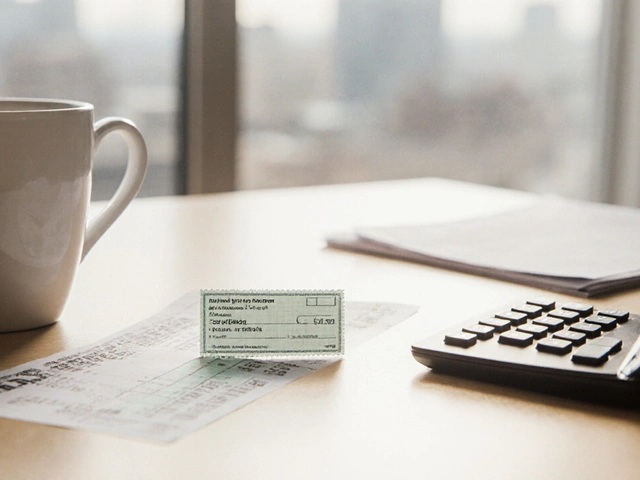
If money really can buy happiness, earning enough each month without working like a madman has to be near the top of the list. People Google how much they need to invest for $3,000 a month because that’s real-life breathing room—it’s half the rent or all the groceries, plus some left for actual fun. But the math behind this isn’t just plugging numbers into a calculator. The answer changes depending on what you’re willing to risk, what you expect for returns, and how hands-off you want to be. If you think there’s one universal answer to how much you need to invest, you’re in for a surprise.
What Does $3,000 a Month Mean for Your Investments?
Before you jump to the calculators, let’s put $3,000 a month, or $36,000 a year, in context. It’s steady income—one that could pay for a chunk of living expenses or even replace a part-time job for many people. If you want to pull this off with investments, everything depends on what you invest in and what kind of risk and reward mix works for you. For most folks, the magic behind sustainable monthly income is tied to something called the "safe withdrawal rate." That’s just a finance nerd way of saying, “How much can you pull out of your investments each year without running out of money?”
The classic rule is the "4% rule." If you’ve ever fallen down a Reddit personal finance rabbit hole, you’ve come across it. Basically, if you invest in a well-diversified portfolio—think a mix of stocks and bonds—you can safely take out 4% of your starting amount each year, and your money should outlast you (not financial advice, just the historical math). But 4% isn’t set in stone. The last decade saw the experts argue it could be closer to 3.5%, especially if you want to play it ultra-safe or you’re planning for super-long retirements. Some folks stretch it to 5% in a booming market, but that brings real risk.
Here’s the fun part—how does that work out in real numbers? To pull $36,000 a year using the 4% rule, you’d need:
- $36,000 ÷ 0.04 = $900,000 invested
Almost a whopping million bucks. It sounds like a scary mountain, especially if you’re busy raising kids, hustling in your job, and watching eggs hit $7 a dozen. But this number is just a starting point. If you dared to nudge your withdrawal rate to 5%—let’s say you’re investing in something a bit riskier or you’re feeling bold—it drops:
- $36,000 ÷ 0.05 = $720,000 invested
But remember, a higher withdrawal rate means a higher chance of running out if the market tanks. Go on the cautious side and stick to 3%, and suddenly you need:
- $36,000 ÷ 0.03 = $1,200,000 invested
If you’re chasing $3,000 a month, keep asking: How much risk can I stomach? What’s more stressful—running out of money, or not making enough now? For plenty of families, like mine, working through these numbers sparks a lot of late-night kitchen table talk. Larissa and I have gone over these calculations more times than I can count. The biggest tip: don’t just aim for the lowest possible number. Plan for a wiggle room because life finds a way to toss curveballs when you least expect it.

Where to Invest: Choices, Returns, and Real Examples
Once you know roughly what your magic number is, comes the more interesting decision—where do you stick this stack of cash? This part separates dreamers from folks who actually see that $3,000 rolling in each month. Let’s dig into the most popular—and practical—ways regular people get monthly income from investments.
invest for passive income is not a one-size-fits-all plan. The flavor changes whether you're tossing it into index funds, hunting down dividend stocks, eyeing real estate, or chasing the newest crypto coin. Here’s how each option might look in real life, with honest talk about the pros and potholes:
- Dividend Stocks & Index Funds: This is the playground for people who want to sleep at night and still see cash. S&P 500 ETFs often dish out 1.5% to 2% in annual dividends these days. High-dividend stocks or specialty dividend-focused funds might push 3% to 5% if you don’t mind more risk. On $900,000 at 4% yield, that’s just at the $3,000 a month mark. But stock markets can get wild—a crash drops yields (and your base). You can reinvest dividends during your accumulation years, and then shift gears to start pulling cash when you need it. Real talk: if you want “set it and forget it,” this is the least stressful door.
- Real Estate: The classic path. Rental properties feel simple—buy a place, rent it out, collect checks. But the math can get ugly fast with maintenance, property taxes, vacancies, and tenant drama. After all costs, average real cash-on-cash returns often hover around 7-8%—but only in high-demand areas or if you’re a solid landlord. Crowdfunding and REITs open doors if you don't have six figures lying around. A solid duplex in a Midwest town could cash flow $400 a door, but you’ll need several properties to hit $3,000 reliably, especially if you build in a buffer for repairs and rough months.
- High-Yield Savings, CDs, Bonds: Not the sexiest option, but if you want ultra safety, treasuries and CDs now sprinkle out 4-5% annual interest (as of 2025). The tradeoff is your principal doesn’t grow much above inflation. On $900,000 in treasuries at 4%, you’d pull off $3,000 a month, but you lose out on compounding. For old-school safety-first savers, it only really works if you already have a large nest egg and don’t need big growth. My grandma swore by this, and she slept well—but she had lower expenses than most families today.
- Alternative Routes: For the bold (or, let’s be honest, the bored), there’s crypto staking, peer-to-peer lending, or micro-investing in startups. The appeal? Sky-high possible yields. The downside? The risk of losing your entire capital is real. I dabble, but only with “fun money” I can laugh about losing. No way would I bet Keegan’s college fund or the emergency cash here.
Mix and match as fits your comfort zone. A lot of people blend: some index funds, a rental or two, some cash on hand. That way, if one pillar wobbles (say, your rental goes vacant for months), you still have checks from others. I always remind friends: don’t chase yield so hard you lose sight of safety. No monthly payout is worth lying awake worrying about bankruptcy or market crashes.

Smart Moves and Common Pitfalls on the Road to ,000 a Month
If you’re serious about locking in $3,000 a month in passive income, there’s no way around being strategic. Deciding how much to invest is only half the battle—keeping that income steady is where the real work starts. Here’s where a lot of people get tripped up, and how you can dodge their mistakes.
- Don’t Underestimate the Slap of Taxes. The numbers above? They’re pre-tax. Depending on what you invest in—dividends, bond interest, rental income—the government might want a chunk. Rental income can be offset with deductions like mortgage interest or depreciation. But dividends and interest get hit with their own rates. Always triple-check your after-tax yield to make sure $3,000 a month is still realistic for your pocket and not just a pipe dream before Uncle Sam calls.
- Diversify Like Your Sanity Depends On It. It’s tempting to dump every dollar in whatever feels “hot” this year. Last year it was AI stocks, before that crypto, before that real estate. But every asset class runs into storms. An index fund can lose 30% in a bear market. Downtown properties might empty for months. Spread it around so that one bad year isn’t a disaster. My portfolio is part boring S&P 500 fund, part rental, part blue-chip dividend stocks, and a pinch of weird experiments (I can’t resist).
- Automate Contributions, Not Decisions. Setting up auto-invest isn’t just about laziness—it’s a way to smooth out the crazy in the markets. You buy more shares when prices are low and less when they’re high. But don’t ‘set and forget’ review. At least once a year, check your numbers. Did you reach that $3,000 target with dividends and interest last year, or is your portfolio limping along at $2,200? Course-correct yearly, not after a decade when you realize you’re way off.
- Inflation—The Silent Thief. A fixed $3,000 every month might look chunky now, but with the way prices creep up, you need your investments to grow over time. Stocks usually beat inflation long-term, which is why so many people stick to the 4% rule with a blended stock-bond portfolio.
Kids throw surprises into any long-term plan (ask me about the time Keegan “accidentally” flooded the laundry room). Be ready to hit pause, lower investments for a while, or cover big one-off expenses. It’s better to build flexibility into your plan than pretend you can invest a fixed amount every month for 20 years straight without any hiccups.
Here’s a tip that changed my approach: try to create multiple layers of income, not just one. Maybe your first $1,500 a month comes from investments, the next chunk from a side hustle, and the last bit from a rental or freelance gig you don’t hate. This takes the pressure off pumping a crazy-big sum into one basket. A lot of us figure out, along the way, that freedom comes from having options—not from obsessing over a spreadsheet number as life hurls tomatoes at your plan.
If you’re just starting and can barely save, don’t let that million-dollar number scare you. Most people never hit it by leap—just steady, boring stair-steps. Monthly investing, cutting out dumber expenses (my weak spot is gadgets, Larissa’s is travel), and letting time do its thing. Watch for lifestyle creep as income grows; nothing eats into your investable money faster than upgrades that feel urgent when your paycheck jumps.
To wrap up, $3,000 a month in investment income is real, reachable, and absolutely worth shooting for. But the size of the hill depends on your choices—where you pile money, what returns you expect, and whether you’re riding high or hedging for storms. Get specific, question every step, and don’t let anyone sell you a simple answer. Your path might take a little longer or twist through markets you never thought about. The important part? Start the climb. Compound interest, as they say, is the eighth wonder—and time is always your best friend on this road.








Write a comment